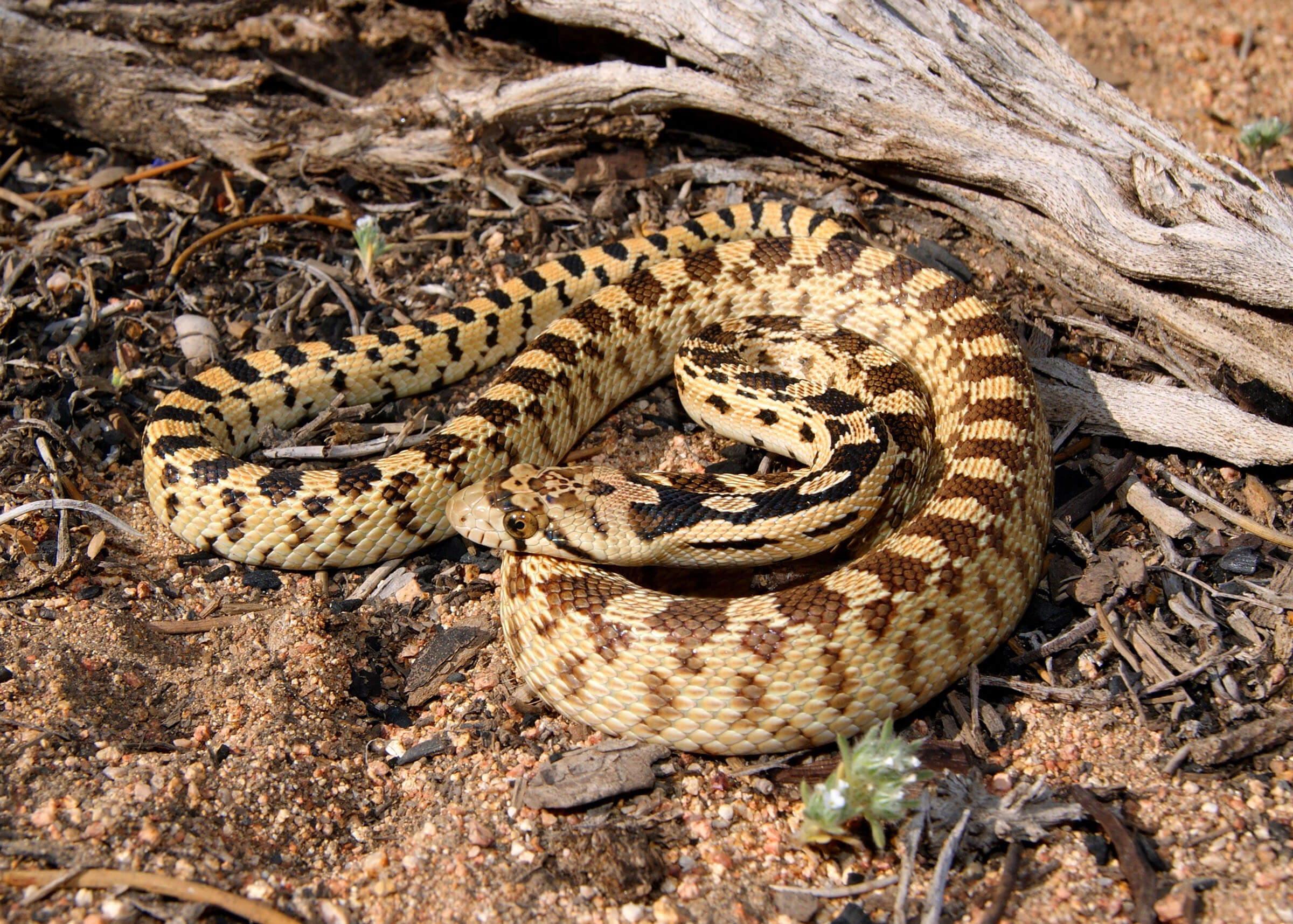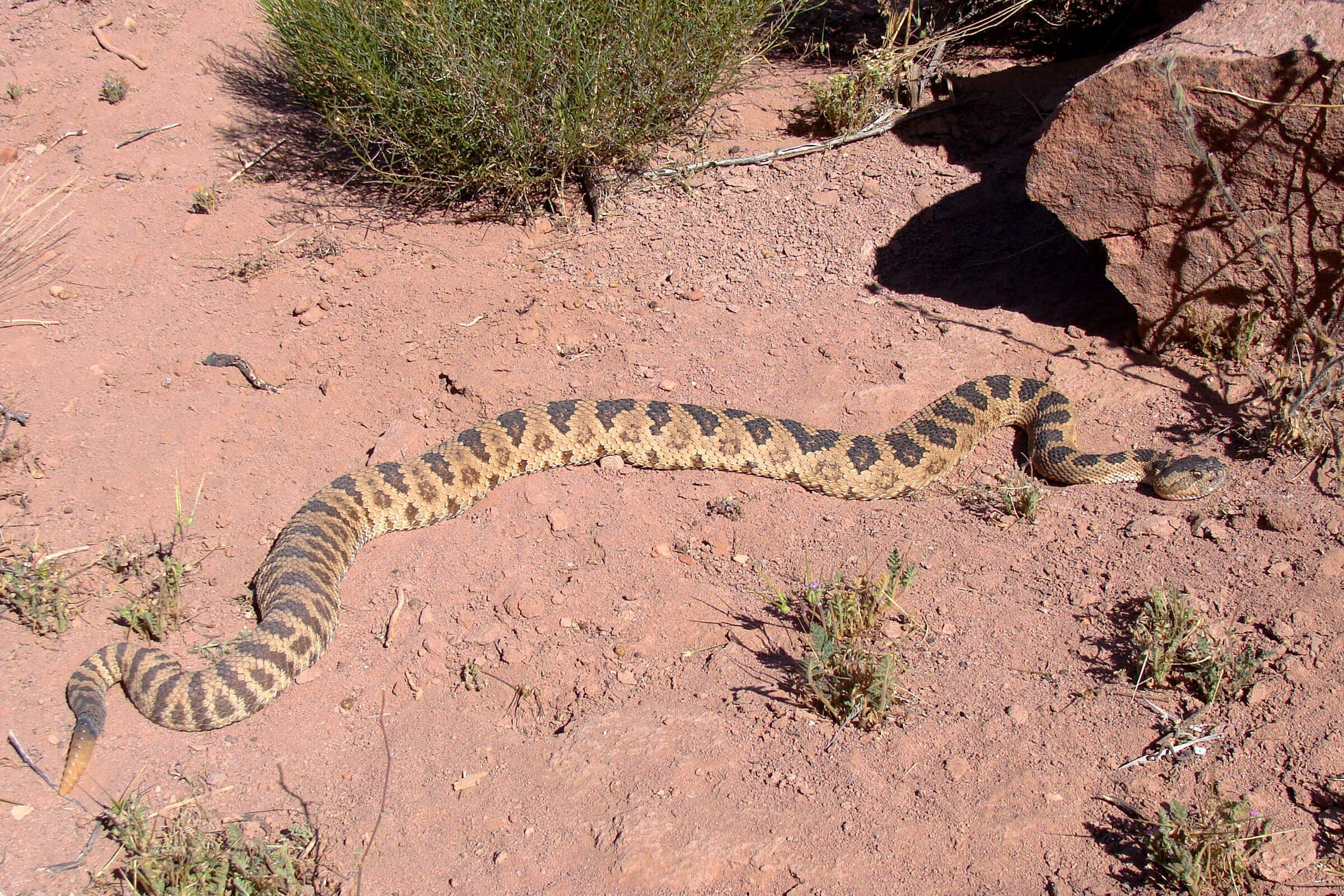Rattlesnakes can be found throughout Nevada primarily in open, rocky areas. We have 6 species of rattlesnakes in Nevada. They can be identified by a broad, triangular head with venom glands, and a rattle at the end of their tail. Rattlesnakes play an important role in the ecosystem. They are effective predators on many rodents, including those that carry hantavirus, plague, and salmonella.

Compare the slender head and pointed tail of the nonvenomous Gopher snake (locally referred to as the bull snake).
Are rattlesnakes dangerous?
All rattlesnakes are venomous. All other native Nevada snakes are harmless to humans and are therefore not a threat. Rattlesnakes are capable of lunging at least 2/3 of their body length to inflict a bite at lightning speed when necessary. Juvenile rattlesnakes are fully capable of inflicting venomous bites.Rattlesnakes will not always rattle before a bite, nor do they always bite after rattling. The rattle serves as a warning if the rattlesnake feels threatened. Sometimes, a rattlesnake will hold completely still if it does not think it’s been seen by its potential predator. In these instances, people might fail to notice their presence and step on it, causing the snake to inflict a bite. Refer to the Department’s ‘Venomous Reptiles of Nevada’ brochure or Southwest PARC’s ‘Living with Venomous Reptiles in the Southwest.‘
When are rattlesnakes most active?
Rattlesnakes are most active from March to October and can be seen during the day or night. During the summer, when temperatures rise above 90°F, rattlesnakes temporarily seek shelter in rock crevices, burrows, vegetation, or sand to avoid overheating. Rattlesnakes come out of their refuges to thermoregulate, eat, drink and mate during this active time of year. Oftentimes, rattlesnakes are encountered in urban areas including shaded yards, garages, or covered patios because the snake needs to escape the heat and the human-altered landscape is cooler than the open desert. During the winter, when temperatures are consistently below 60°F, rattlesnakes usually seek shelter to stay warm; here they hibernate, or brumate, for the winter months. Rattlesnakes do not often come out of their refuges during this inactive time of year and when they do, they do not go far before retreating back into their winter refuge.
How do I keep rattlesnakes out of my yard?
It is very difficult to exclude snakes from any area. Snakes can easily slip through chain link or chicken wire fencing. They are agile climbers and climb cinder block walls or other solid fences with ease. If a fence is tall enough (over five feet) and constructed to angle away from the protected area, it is much more difficult for a snake to climb over. This fence design can be found at: Internet Center for Wildlife Damage Management.
A great way to prevent rattlesnakes from wanting to visit your yard is by limiting snake habitat. Keep your yard clean and neat. This will help prevent rattlesnakes and other critters from taking up residence too close to your home or garden. Wildlife often look for places to take cover and find shade. Prevent the buildup of bird seed under feeders – this attracts rodents and birds. Snakes will eat both!
What do I do if I find a rattlesnake?
If a rattlesnake is found in the wild, leave it alone. Trying to needlessly harm, kill or move a rattlesnake only puts you at risk. If left alone, rattlesnakes will leave an area where there are humans. Refer to the Department’s ‘Venomous Reptiles of Nevada.’
If you are in Northern Nevada and would like to discuss snake removal, please reach out to Get Rattled at 775-250-7625.
If a rattlesnake is posing a public safety threat in Nevada, call 911.
What should I do if I find a rattlesnake inside my house?
If you find a rattlesnake inside your house, please reach out to us immediately and keep an eye on where the snake is located. Please do not lose track of where the snake is and make sure to have eyes on the snake when you call. If you can safely do so, please place a trash can over the snake until a NDOW warden responds to remove it.
How can I prevent rattlesnake encounters out hiking?
A rattlesnake’s first instinct is not to bite you but to flee, so if you happen to come across a rattlesnake, give it space!
- Be aware of your surroundings—look before you step, sit, or reach!
- Step on top of rocks, not over them.
- Wear long pants and avoid thick brush.
How can I keep my pets safe from rattlesnakes?
Pets and rattlesnakes do not mix, so when you are out recreating or allowing your pet outside, making sure to secure your pet first is a great first step to ensuring their safety.
- Always walk your pets on a 6-ft leash, not just for rattlesnakes but other wild animals as well!
- Never allow them to interact with wildlife.
- Never allow them to stick their heads in holes or in places you can’t clearly see.
- Look into snake avoidance training for dogs. This teaches them to stay away from rattlesnakes and can be very useful if you recreate outside frequently.
What is the difference between a rattlesnake and a gopher snake?
Rattlesnakes are venomous snakes that can often be mistaken for gopher snakes. Gopher snakes (also known as bull snakes) are non-venomous snakes that can be found throughout Nevada. Gopher snakes have slender bodies and heads, they also have markings that are quite similar to rattlesnakes. Don’t let them trick you though! Gopher snakes are known to mimic rattlesnakes when they feel threatened. They will flatten out their heads and shake the tip of their tails in brush to mimic the sound of a rattle!

